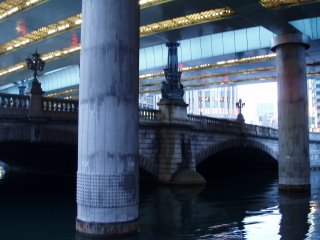Tokyo 2006 Part V: Nihonbashi
Nihonbashi - the name of a bridge and its surrounding area - used to be the center of Japan. When the Tokugawa Shogunate began its more than 250-year rule in 1603, it built the five main roads connecting Tokyo (then called Edo) and different regions of Japan from Nihonbashi. In other words, all the roads in Japan headed towards Nihonbashi. During the early 20th century, Nihonbashi was the major business and financial district - there are still the headquarters of Mitsukoshi department store and the Bank of Japan (Japan's central bank). Even today, the official distance from Tokyo to anywhere in Japan is measured from Nihonbashi.
Despite its historical significance, Nihonbashi keeps a low profile today because of this:
Overshadowing the Nihonbashi bridge is a motorway (Tokyo Metropolitan Expressway) built in 1964, when Tokyo hosted the Olympics. It's probably the ugliest cityscape in the world. Last year Prime Minister Koizumi encouraged the plan to remove the motorway in order to improve the landscape (a news article). Debates are going on about how it is done (and my dad is involved in this debate).
But I realize that the view of the bridge after dark is not that bad:
Of course, it's not beautiful. But this view is probably unique to Nihonbashi. Nowhere around the world you will see this.
Walking to the north from the Nihonbashi Bridge, you will see another spectacle: Mitsui Main Building (the former headquarters of Mitsui business group):
Isn't this marvelous in the sense that a Neoclassical architecture has got a golden kanji (Chinese character) sign that reads from top to bottom (the Japanese and Chinese way of writing a sentence)? It reads Chuou Mitsui Shintaku Ginko (Chuou Mitsui Trust Bank). The building was built by Americans from 1926 to 1929, after the Great Kanto Earthquake destroyed the whole city of Tokyo in 1923. Traditionally Japanese buildings were built of wood. Everytime there was an earthquake followed by fire disaster, all the buildings were gone. That's why you see few old buildings in Tokyo. In the late 19th century and the early 20th century, when Japan began its modernization, many Neoclassical architectures were built of stone. You still see some of them in Nihonbashi and Ginza areas (and in Seoul as well). The Nihonbashi bridge wasn't an exception - it used to be built of wood (and burned down 18 times) and then in 1911 the current form of the stone bridge was constructed.
In this sense, it's understandable that Japanese people at that time thought Western architecture was advanced and a model to follow. Exploring Nihonbashi makes you think of that era in Japan, which was unthinkable to me when my parents often took me as a primary school kid to Nihonbashi in order to shop at the Mitsukoshi department store (and I liked its toy store section).
1 comment:
Masa,
I took an interesting route - from Nihon Bashi down by the river towards Nigyocho and Sangoku.
fascinating route - Ningyocho was very unique for me - visited the Ningyo shops-quite different from Modern Tokyo.
Also the homeless people on the opposite bank of Sangoku by the river was a strange contrast.Its near a park which name I cannot recall.
Post a Comment